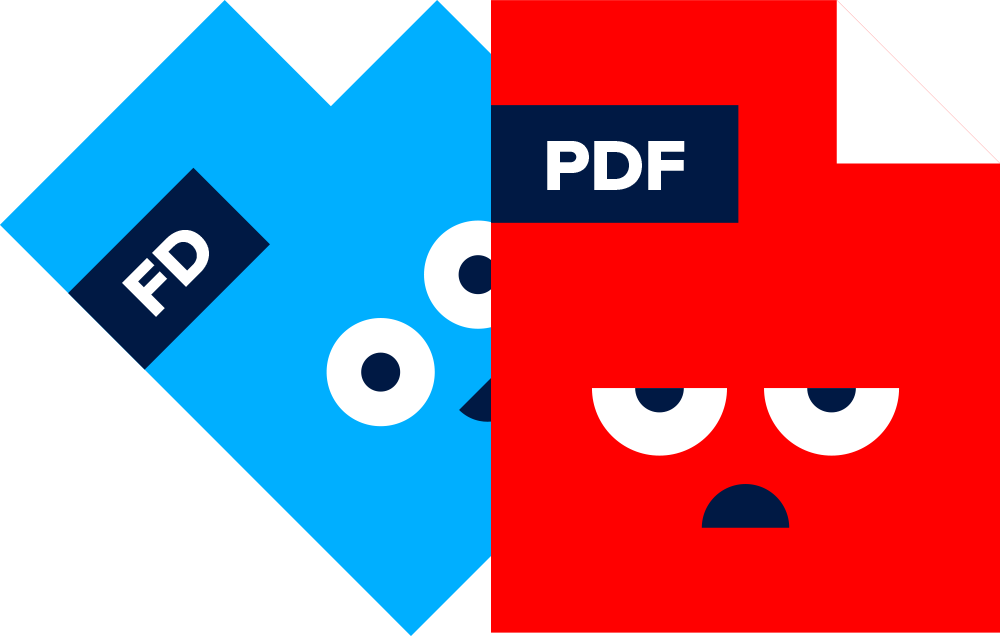Introduction
Finding the right place to create and publish your content is never straightforward. Should the content piece live on your main website? Or would it be more suited to something immersive and interactive, like a Foleon Doc? And how does content creation in Foleon compare to creating content in your CMS?
This guide breaks down when to create content for your website and when an interactive, immersive content format like a Foleon Doc is the best choice for your goals.
Foleon Docs vs website content: What's the difference?
First things first, let's get our definitions straight. Foleon is a platform that lets you create, review, and publish interactive content pieces called Foleon Docs. Like websites, Foleon Docs use HTML5, CSS, and JavaScript.
Discover: What is a Foleon Doc?
While they share the same technology, their usage is very different. A website (as its name implies) is like a spiderweb where everything is connected to everything else. Docs made with Foleon provide a more self-contained experience, keeping readers engaged for longer.
Why create website content?
Your business’s website acts as the primary hub for your brand’s online presence. It provides your audience with a navigable, structured space to do their own research, learn about your business, or get in touch with a representative.
Websites are designed to host evergreen content, like your company homepage, blog posts, or About Us page. Website content also plays an important role in your SEO strategy, driving organic traffic and making your brand easier for prospects to find.
Creating website content
Creating content that lives on your website or CMS can be a complex operation. Most web CMS implementations leave you with a number of purpose-built page templates for things like landing pages and blog articles. And that’s pretty much it.
Any kind of custom content experience needs to be built from the ground up. Here's an example of a typical website content creation process;
- First, designers need to create wireframes and design the page down to individual elements.
- Then, your developers need to build the custom page (or pages) that you need for your content piece.
- And if that wasn’t enough, you need to run tests on your content before putting it live.
All of these steps require a great deal of custom work from specialists, and can take weeks or even months to complete, depending on the complexity of the project.
Beware of the website content workaround
And if you try to bypass the designing and development phases because you’re on a deadline? You end up with a Frankenstein piece of content, made up of elements from other purpose-built templates, pasted together. Not quite the seamless experience you were aiming for.
Why create content in Foleon?
Foleon is built for creating immersive content experiences that live alongside your evergreen website content. Think about all of the content you create that isn’t on your primary website, like PDF reports, e-books, and even sales proposals. All of this lives outside of your website for several reasons:
Enhancing reader engagement
If it’s an important content piece that demands readers’ full attention, you want them to stay engaged throughout. If they’re on your website, a reader is more likely to get sidetracked and switch between pages.
One-off or time-bound content
Or maybe the asset has a specific shelf life, like an event brochure. Would it make sense to go through the hassle of building it on your website if it’s only going to be there for a very short time? Probably not.
Where the Foleon format shines
While a website is perfect for users doing independent research, Foleon’s immersive format is a better fit if you want something self-contained and highly engaging. On average, users tend to interact with Foleon Docs four times longer than a typical web page.
Standalone content that isn't a dead-end
Unlike traditional formats for self-contained content, like PDFs, Foleon content is fully trackable, allowing you to gather audience insights and understand your reader behavior and interest level. And if you want to drive traffic back to your primary website? Just add a link in your Foleon Doc. It really is the best of both worlds.
Check out: 5 PDF Alternatives To Bring Your Business Docs Into This Century
Creating content in Foleon
While creating website content relies heavily on specialists like designers, developers, and HubSpot, WordPress, or Drupal admins, Foleon’s no-code platform is flexible and straightforward enough for anyone to use, regardless of technical expertise.
Straightforward creation for non-specialists
The intuitive drag-and-drop editor allows non-designers to create interactive documents using a huge library of easy-to-customize page and block templates. But that doesn’t mean you have to worry about non-specialists going rogue. While traditional CMS platforms don’t have any brand guardrails, increasing the risk of introducing incorrect colors or formatting errors, Foleon’s governance features ensure that all content stays on-brand, no matter who creates it.
A custom web experience — minus the hassle
Foleon also eliminates the slow, back-and-forth process often required when publishing new content in a CMS. There’s no need for endless previewing, troubleshooting, or developer tweaks; what you see is what you get. If you’re looking to quickly create customized web-based content without custom development or design work, Foleon is the ideal alternative.
How can Foleon and your website work together?
Your website content and your Foleon Docs can be a winning team when deployed at the right moment. Here’s how the two can support one another:
Different experiences for different stages of the journey
As we’ve already mentioned, the navigable experience of a website and the contained, immersive experience of a Foleon Doc work well for different content goals. The trick to getting the most out of both platforms is to understand where your content piece fits into your audience’s journey.
Here’s an example of how to deploy both Foleon Docs and website content in a strategic way:
- Start by driving traffic to your website with an SEO-optimized blog post.
- Then, at the end of the article, include a CTA for an interactive report created in Foleon, giving readers the opportunity to dive deeper into the topic.
- Embed a lead capture form within the Foleon Doc, allowing you to follow up with high-priority leads based on reader insights gained in Foleon.
Used in the right way, a Foleon Doc can be a powerful tool to help drive traffic back to your website or directly towards a conversion point, depending on your goal.
But wait, what about SEO?
If the goal of your content is to rank on Google, then your website is the most obvious choice. Generally speaking, Foleon Docs won’t boost SEO rankings for your primary domain — unless you choose to self-host. That being said, Foleon Docs are built with SEO in mind. You can set meta titles and descriptions, alt tags, language headers, and even canonical links to prevent competing with other high-priority content. Try doing that in a PDF!
To index or not to index — the choice is yours
And if you're working with internal or sensitive documents, you can also prevent search engines from indexing your content — no need to worry about sensitive information showing up on Google.
Create commercial docs that support your SEO efforts
A Foleon Doc is a great choice if you want to create content that supports your overall SEO strategy but isn’t intended solely to rank. For example, your SEO-optimized blog could live on your main website, while your other commercial documents, like white papers and reports, could live in Foleon Docs, which link to your parent domain, strengthening your overall rankings.
Want to learn more about how Foleon can support your SEO strategy? Check out our guide.
How to choose the right solution for your content
Still not sure whether your content should live on your website or in a Foleon Doc? We’ve created a handy cheat sheet to help you make the right choice:
Are you looking for a custom experience with a quick turnaround?
Go for a Foleon Doc. Foleon assets are quicker to produce and easier for non-technical users to customize themselves. This means you can get the bespoke feel you’re after, without having to wait for design and development resources to be freed up.
Is the main goal of the content to boost SEO rankings for your primary domain?
Your website is likely the best choice here. But if you want to create something more self-contained, Foleon lets you create an immersive experience while still boosting your overall rankings.
Is reader engagement a top priority?
Think about how you want your reader to interact with your content. Are you conveying critical information that demands their undivided attention? Foleon’s immersive format keeps readers engaged for longer and means they're less likely to get distracted.
As a rule of thumb, if it would have been a static PDF a few years ago, Foleon should be your go-to.
Is the content evergreen?
Here, we’re talking about content that won’t need to be changed often. These are things like your homepage or your About Us page. These kinds of content are the best fit for your website.
Final thoughts on website content vs Foleon
Foleon and your website can serve two distinct, but complementary roles when used together strategically. While your website serves as a central hub for your brand’s evergreen and SEO-driven content, using Foleon alongside your website content allows you to produce interactive content faster and provide readers with immersive experiences for deeper engagement.
To choose the right platform for your content, consider factors like the goal of the content, your available creation resources and timeline, and your overall content journey and strategy.




